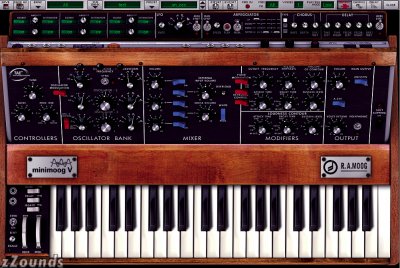MiniMoog
Arturia Minimoog V Software Synth (Macintosh and Windows)
1971. At the NAMM convention, Bob Moog introduces the Minimoog, the very first compact and affordable synthesizer for musicians. With its fat sound and unparalleled filters, the Minimoog eventually became responsible for some of the best analog synth bass and lead sounds ever:
2004. At the NAMM show, Arturia introduces the minimoog V, a faithful reproduction of the Minimoog. Offering all the features of the original, the software version also brings polyphony, MIDI management, presets, coupled with other advantages of modern tools - behind the control panel are additional functions: a modulation matrix, an arpeggiator and an independent LFO as well as a stereo chorus and a delay.
But what about the core of the Minimoog, the sound? Thanks to TAE (r), Arturia?s proprietary technology for emulating analog circuits, the minimoog V offers an unchallenged quality of sound. Sharp filters, aliasing-free oscillators, soft-clipping guarantee you have the best analog emulation on the market.
The minimoog V comes loaded with more than 500 presets made by a selection of talented sound designers. It is certainly an instrument which is going to bring a lot to your musical palette.
ARP2600

Moog Modular

Ever dreamt of using one of the best synthesizers ever made? Ever dreamt of working with a modular system whose sound is part of musical legend?
Arturia, in partnership with Bob Moog, has made it possible with a faithful reproduction of one of the most famous series of synthesizers: Moog Modular.
Endless synthesis
Because it is modular, the Moog Modular V offers endless possibilities for synthesis.
9 oscillators, 3 filter slots, 2 LFOs, 6 envelopes, VCAs, mixers, triggers, a 3x8 step-sequencer, etc.
With such an instrument, you can make all types of combinations and create sounds that were never heard before.
Pure analog
TAE®, standing for True Analog Emulation, is a new technology developed by Arturia, enabling the digital reproduction of analog circuits. The implementation of TAE in Moog Modular V results in:
- aliasing-free oscillators, at no extra CPU cost.
- better reproduction of analog oscillators: the condensers' unload and the oscillators' instability are simulated, helping to reproduce a typical warm sound.
- very accurate reproduction of the legendary Moog 24 dB low-pass filter.
- implementation of soft clipping, i.e. reproduction of the filters' current limiting function.
Benefit from the experience of the best sound designers
The Moog Modular V comes loaded with more than 400 presets made by a selection of the most talented sound designers.
What's new in Moog Modular V2 ?
New ergonomics:
- One unique scrollable view to overlook the entire synth.
- Some of the modules are now interchangeable, allowing to configure - to a certain extent - the Modular the desired way.
- Improvements on the oscillators (new free running), on the filters (better response to modulations), on the envelopes (faster and even closer to true analogical behaviour).
- New Unison mode
- New Audio-In possibilities
- The Soft-clipping emulation is now done on each mixer and not systematically on all of them, which saves on CPU load.
- 1630 Bode Frequency Shifter. Developed under the Moog license by Harold Bode in 1964, it is extremely rare (a dozen Worldwide).
- 928 Sample and hold is also very rare. Originally assembled in a separate cabinet, it was adapted on the last modular series, in the late 70's.
- 912 Envelope follower (or Schmit Trigger). One of the most popular modules on the Moog systems, it was often added to original configuration to create complex modulation through the use of an output signal.
- 12 stage phaser. The Moog 12 Stage Phaser was very well known, and originally conceived as an external rack to the Modular systems.
- Formant Filter. A new module developed by Arturia, which did not exist on the original Moog systems. It allows the filtering of sounds according to the formants a, e, i, o, u.
- Ring Modulator. Also a new module developed by Arturia, it creates very metallic sounds.
Download:
http://www.megaupload.com/?d=TNBQK23N



No hay comentarios:
Publicar un comentario